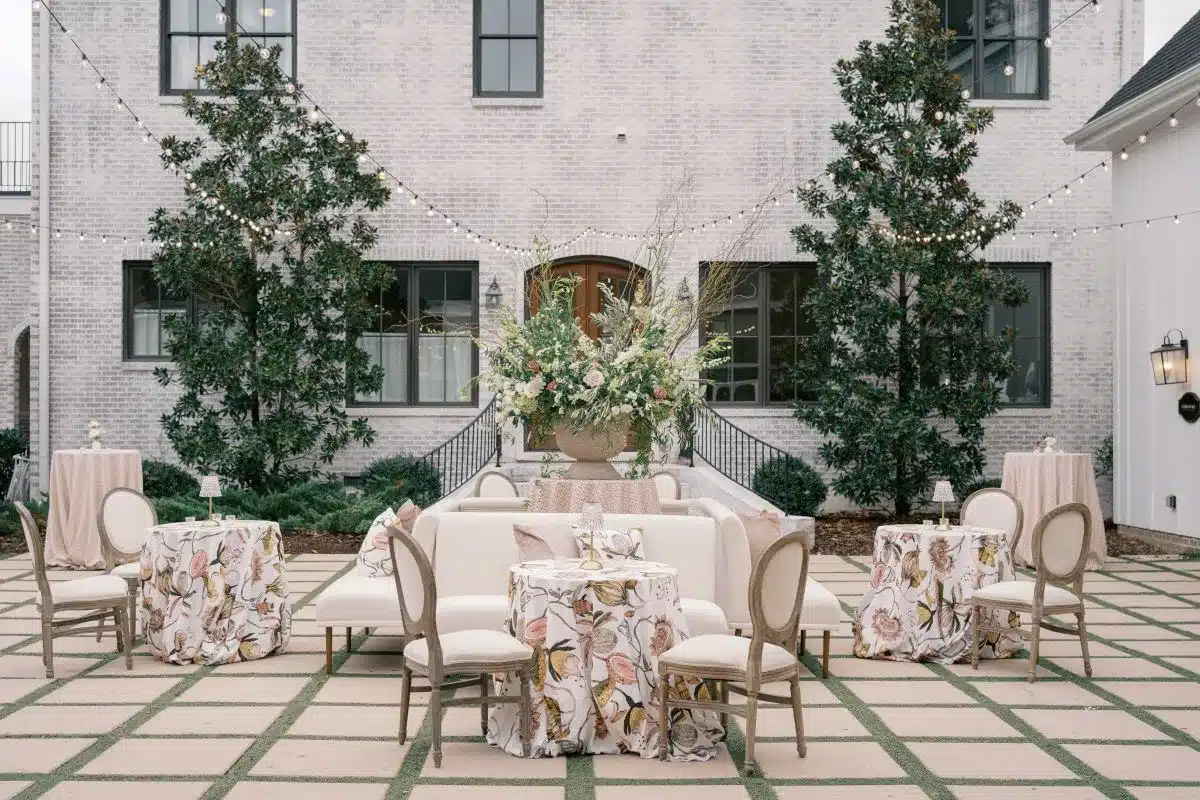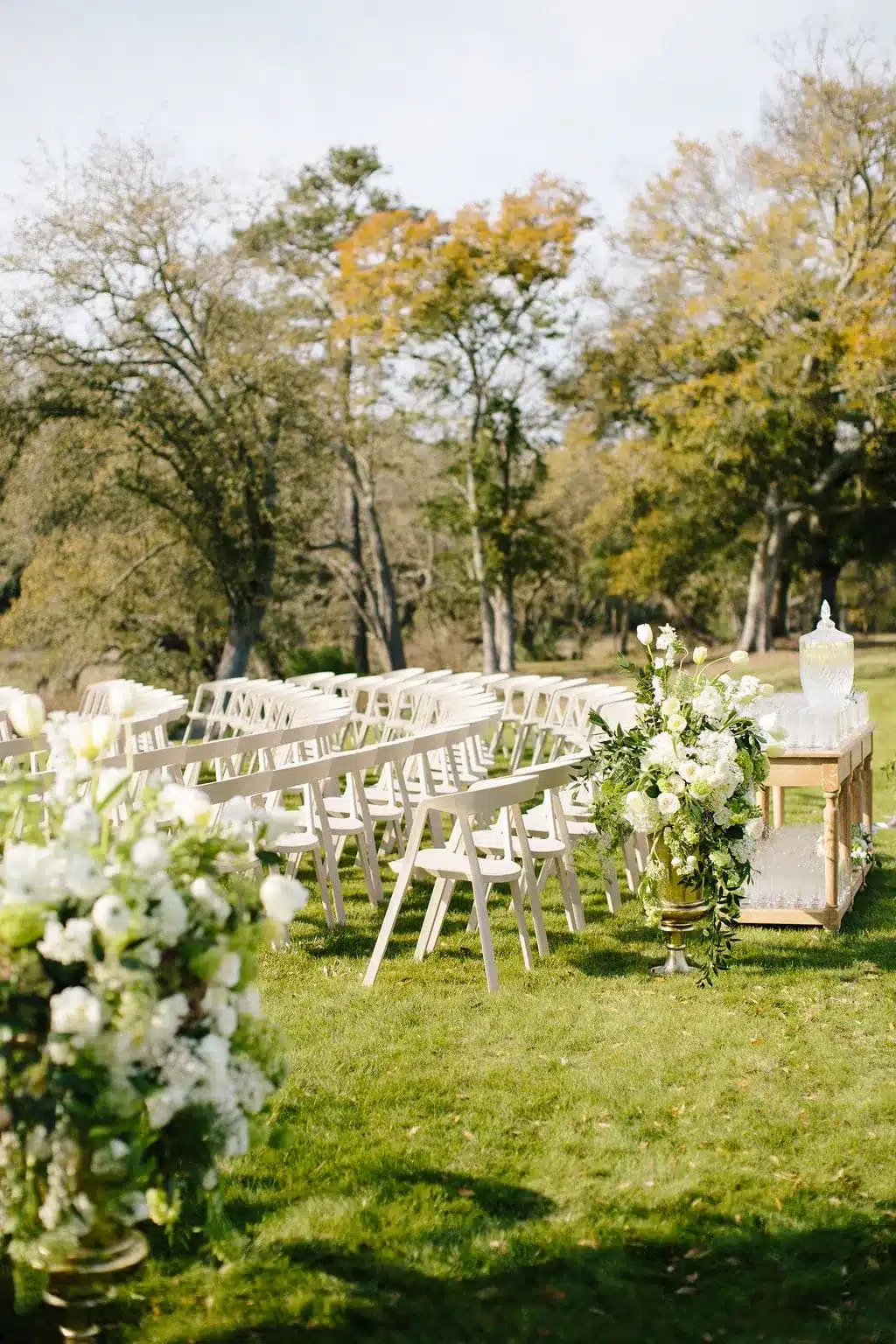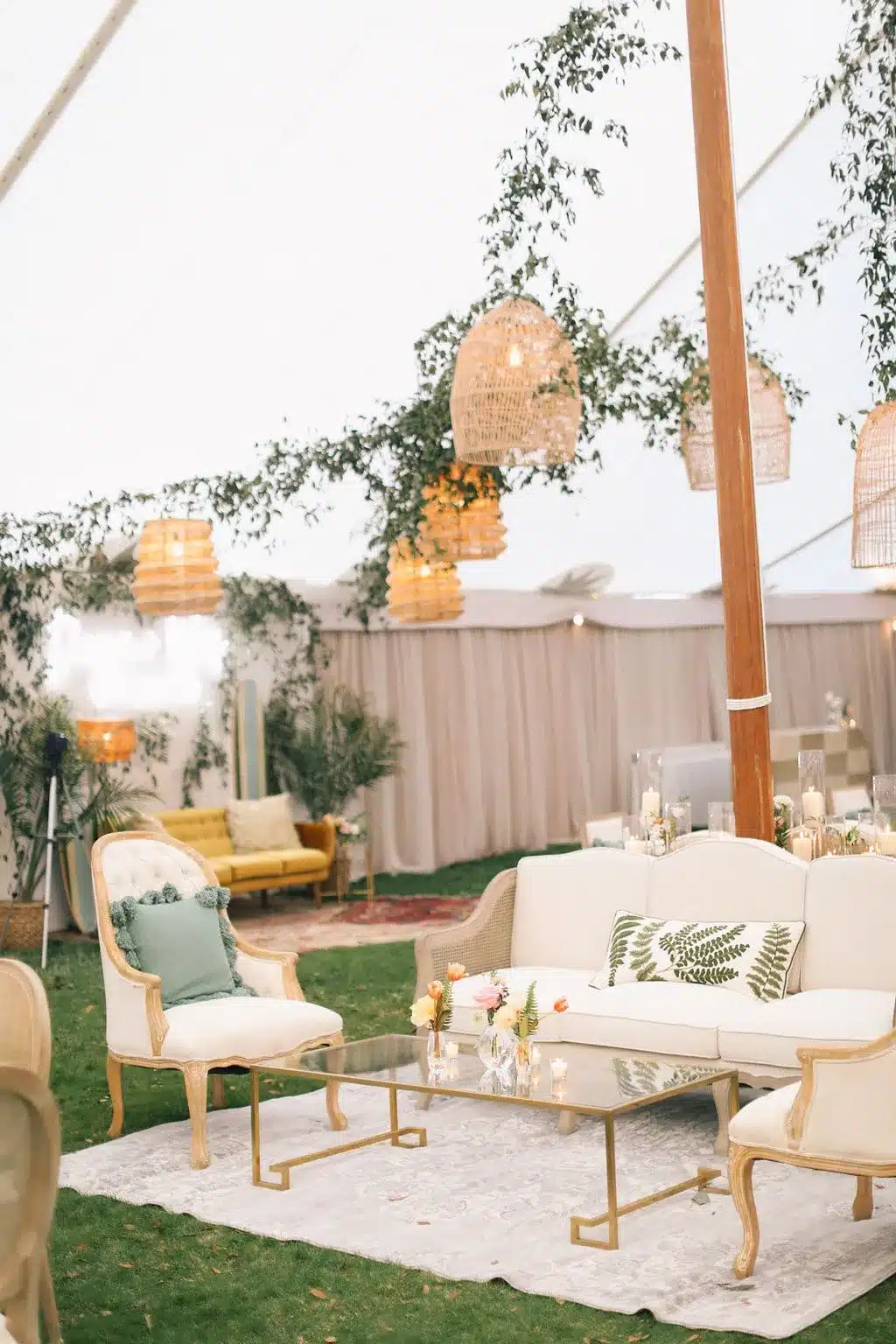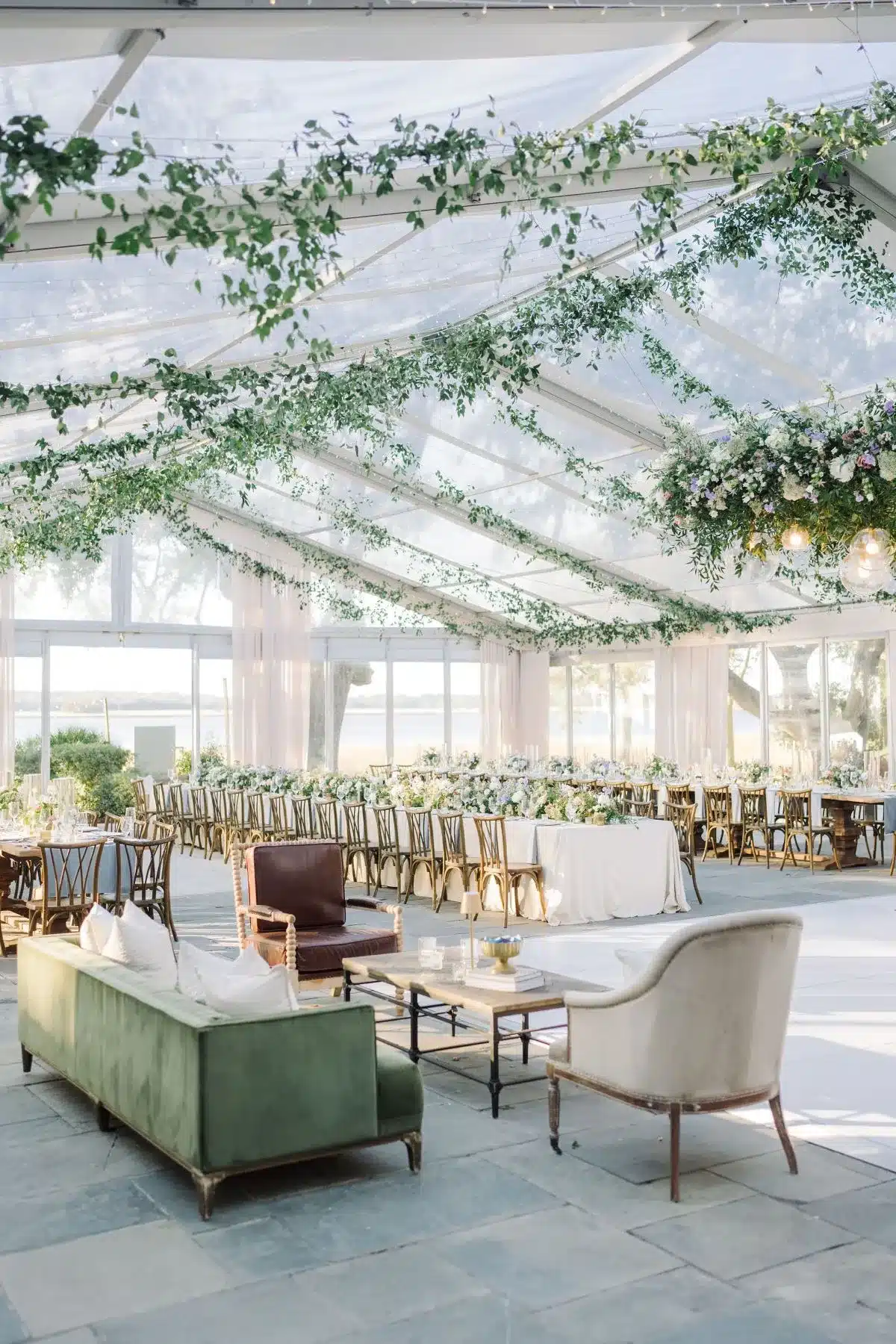Are you struggling to arrange furniture for your wedding venue? A well-planned layout can transform your space, ensuring comfort for guests and creating a stunning atmosphere. This guide will cover key elements of wedding furniture layouts, popular styles, and a step-by-step process for creating your ideal setup. You’ll learn how to maximize space, coordinate with rentals, and finalize a layout that enhances your special day. By the end, you’ll have the knowledge to design a functional and beautiful wedding venue layout.
Key Takeaways
- Effective wedding furniture layouts enhance guest flow, atmosphere, and overall event success.
- Venue assessment and furniture selection are crucial for creating an optimal layout.
- Maximizing guest comfort and accessibility is essential for a memorable wedding experience.
- Modern and unique layout ideas can create lasting impressions and showcase couple personalities.
- Finalizing layouts involves venue walkthroughs, logistical adjustments, and preparation for last-minute changes.
Understanding the Importance of Wedding Furniture Layouts for Memorable Events

Wedding furniture layouts play a crucial role in creating memorable events. A well-designed floor plan ensures smooth guest flow, enhances the ceremony atmosphere, and optimizes space for catering stations. Thoughtful arrangement of tables, chairs, and other elements contributes to the overall ambiance and guest comfort.
A floor plan tool can help couples and planners visualize the wedding space efficiently. These tools allow for the precise placement of ceremony seating, reception tables, and various stations, ensuring a cohesive layout that accommodates all aspects of the celebration. Proper planning prevents congestion and creates a harmonious environment for guests to enjoy.
The wedding furniture layout impacts every aspect of the event, from the ceremony to the reception. It influences how guests interact, affects the caterers’ ability to serve efficiently, and sets the stage for key moments like first dances and toasts. A well-executed floor plan enhances the flow of the event, creating a seamless and enjoyable experience for all attendees.
Key Elements to Consider in Wedding Furniture Layouts

Creating an optimal wedding furniture layout involves several key elements. Venue assessment ensures efficient space utilization while choosing appropriate furniture that complements the wedding theme.
Maximizing guest comfort and accessibility is crucial for a memorable experience. Strategic placement of focal points like the wedding cake, photo booth, and chuppah enhances the overall design. Careful consideration of these factors results in a stunning and functional event space.
Assessing Venue Size and Shape for Optimal Layout
Evaluating the venue’s size and shape forms the foundation for an optimal wedding reception layout. Event planners must consider the space available for essential elements such as the dance floor, dining areas, and bar, ensuring a seamless flow for guests attending the wedding reception.
This assessment also helps determine the ideal setup for other events like bridal showers or bachelorette parties, allowing for versatile use of the space. By understanding the venue’s dimensions, planners can create a menu and seating arrangement that maximizes comfort and enhances the overall guest experience.
Choosing the Right Furniture for Your Wedding Theme
Selecting furniture that aligns with the wedding theme enhances the overall ambiance and guest experience. Planners must consider the style, color, and materials of tables, chairs, and other furnishings to complement the chosen aesthetic. Effective communication between the couple and vendors ensures that the furniture harmonizes with the venue’s floor plan and kitchen layout. Attention to detail in furniture selection, from the ceremony space to the reception area, demonstrates proper etiquette and creates a cohesive atmosphere:
Maximizing Guest Comfort and Accessibility
Maximizing guest comfort and accessibility is paramount in wedding furniture layouts. Event planners should consider ample space between tables for easy movement and ensure clear pathways to key areas like the bar, restrooms, and dance floor. Incorporating a mix of seating options, including high-top tables for the cocktail hour and comfortable chairs for the banquet, enhances the guest experience.
Planners must also account for guests with special needs, providing accessible seating and clear routes throughout the venue, whether it’s a barn or a traditional hall. Well-designed floor plan diagrams help visualize these elements, ensuring a layout that facilitates smooth flow and allows guests to fully enjoy the beauty of the event, from the first toast to the last dance:
Popular Wedding Furniture Layout Styles and Their Impact

Wedding furniture layouts significantly impact event aesthetics and guest experience. This section explores traditional seating arrangements, modern configurations, and unique ideas that create lasting impressions. From classic diagrams to contemporary charts, these layouts complement every celebration aspect, from showcasing the wedding dress to honoring the engagement. Understanding these styles provides valuable information for creating stunning and functional event spaces.
Traditional Seating Arrangements and Their Benefits
Traditional seating arrangements offer timeless elegance and practical benefits for wedding celebrations. The classic layout features a central aisle flanked by rows of chairs, creating a picturesque path for the bride’s entrance and the couple’s exit to begin their honeymoon.
This arrangement can be adapted to various venues, from rustic barns with a family tree backdrop to elegant ballrooms perfect for a cocktail party. By providing a clear focal point and ensuring all guests have a good view of the ceremony, traditional layouts enhance the overall experience and set the stage for a memorable celebration.
Modern Furniture Configurations for a Contemporary Feel
Modern furniture configurations offer innovative ideas for creating a contemporary feel in wedding spaces. Wedding planners utilize sleek designs and unconventional layouts to transform venues into stylish environments. These configurations often incorporate mixed seating arrangements, combining traditional tables with lounge areas and high-top cocktail tables.
The strategic use of space and linen enhances the overall aesthetic, while unique drink stations add flair to the event. Modern layouts prioritize flexibility and guest interaction, creating dynamic spaces that flow seamlessly from ceremony to reception:
- Mixed seating with lounge areas and high-tops
- Unconventional table shapes and arrangements
- Creative use of space for interactive stations
- Flexible layouts for easy transition between events
- Incorporation of modern design elements and materials
Unique Layout Ideas to Create a Lasting Impression
Unique layout ideas create lasting impressions at weddings, allowing couples to experiment with aesthetics and showcase their personalities. Innovative arrangements, such as circular ceremony seating or asymmetrical reception layouts, provide stunning backdrops for photography and art installations.
These creative designs offer the bride and groom opportunities to craft unforgettable experiences for their guests, blending form and function in unexpected ways. Planners can incorporate interactive elements, themed zones, or multi-level setups to enhance the overall atmosphere and flow of the event:
- Circular ceremony seating for an intimate feel
- Asymmetrical reception layouts for visual interest
- Interactive food and beverage stations
- Themed lounge areas reflect the couple’s interests
- Multi-level setups to create distinct event spaces
Guide to Creating Your Wedding Furniture Layout

Creating an effective wedding furniture layout requires careful planning and attention to detail. This guide outlines essential steps, from gathering measurements to using design software. It covers planning zones for the ceremony, reception, and lounge areas, ensuring a seamless flow from the altar to the dance floor. By following these steps, couples can design a floor plan that comfortably accommodates their dress, bridesmaids, and guests.
Gathering Necessary Measurements and Details
Gathering accurate measurements and details is crucial for creating an optimal wedding furniture layout. Event planners should use a reliable measuring tool to record the venue’s dimensions, including the shape and size of each area. This information helps determine the number of chairs and tables needed and the placement of larger furniture pieces. Planners must also consider the space required for special elements like the gift table and any unique-shaped decor items that may impact the overall layout.
Planning Zones: Ceremony, Reception, and Lounge Areas
Effective zone planning enhances the flow of a wedding celebration, ensuring a seamless transition from ceremony to reception. Event planners use specialized software to designate marriage ceremonies, meal service, and dancing areas, creating a cohesive layout that guides guests through the event. By strategically placing lounge areas and interactive stations, planners can create inviting spaces that encourage mingling and provide comfort between key wedding moments.
Using Design Software for Visualizations
Design software empowers event planners to create precise wedding venue layouts, including crucial elements like bathroom locations. These tools allow users to account for every detail, from table placements to dance floor dimensions, ensuring an optimal flow throughout the space. Visualizing the layout digitally allows planners to experiment with different arrangements, anticipate potential issues, and make informed decisions about furniture placement, ultimately crafting a stunning and functional wedding environment.
Tips for Coordinating Furniture Rentals With Your Layout

Coordinating furniture rentals with the wedding layout is essential for a seamless event. This section covers selecting reliable rental companies, ensuring consistency with event design, and timing furniture delivery for optimal setup. These tips help couples and planners create a cohesive and well-organized space that aligns with their vision and practical needs.
Selecting Reliable Rental Companies
Selecting reliable rental companies is crucial for a successful wedding furniture layout. Event planners should research potential vendors, checking reviews and portfolios to ensure quality and reliability. They should also discuss delivery schedules, setup procedures, and contingency plans with the chosen company to avoid last-minute issues. By partnering with a reputable rental service, couples can focus on enjoying their special day while professionals handle the logistics of furniture placement and removal.
Ensuring Consistency With Event Design
Ensuring consistency with event design requires careful coordination between furniture rentals and the overall aesthetic. Event planners work closely with rental companies to select pieces that complement the chosen color scheme, theme, and venue style. They consider factors such as table linens, chair covers, and decorative elements to create a cohesive look. By aligning furniture choices with the event’s design concept, planners create a harmonious atmosphere that enhances the wedding experience for all attendees.
Timing Your Furniture Delivery for Setup
Timing furniture delivery for setup is crucial in wedding planning. Event coordinators should schedule deliveries to allow ample time for arrangements and adjustments before guests arrive. They must consider venue access hours, setup complexity, and potential delays when determining delivery times. Coordinating with vendors to ensure a smooth setup process helps create a stress-free environment on the wedding day.
Finalizing Your Wedding Furniture Layout for Success

Finalizing the wedding furniture layout involves crucial steps to ensure a flawless event. This section covers conducting a venue walkthrough, adjusting for logistics, and preparing for last-minute changes. These practices help planners refine layouts, address potential issues, and maintain flexibility on the wedding day, resulting in a well-executed and visually stunning celebration.
Conducting a Walkthrough at the Venue
Conducting a walkthrough at the venue is a critical step in finalizing the wedding furniture layout. Event planners and couples should visit the location to assess the space firsthand, confirm measurements, and identify any potential obstacles. This on-site inspection allows for real-time layout adjustments, ensuring all elements fit comfortably within the venue. During the walkthrough, planners can visualize guests’ flow and note important features like power outlets and lighting fixtures that may impact furniture placement.
Making Adjustments Based on Venue Logistics
Making adjustments based on venue logistics is crucial for a successful wedding furniture layout. Event planners must consider factors such as power outlet locations, lighting fixtures, and architectural features that may impact furniture placement. They should also account for service areas, ensuring easy access for catering staff and vendors. By adapting the layout to the venue’s unique characteristics, planners create a functional and visually appealing space that enhances the overall wedding experience:
- Identify and work around structural elements like columns or stairs
- Optimize traffic flow by adjusting table placement and aisle widths
- Ensure proper spacing for audio-visual equipment and entertainment setups
- Create designated areas for guest book signings, gift tables, and photo displays
- Adapt seating arrangements to accommodate venue-specific features or restrictions
Preparing for Last-Minute Changes on the Wedding Day
Event planners must anticipate and prepare for last-minute changes on the wedding day to ensure smooth execution of the furniture layout. They should create a flexible floor plan that allows for quick adjustments, such as adding or removing tables for unexpected guest count changes. Keeping extra chairs and tables on hand enables swift modifications without disrupting the overall design. Planners should also brief the venue staff and vendors on potential layout alterations, ensuring everyone can adapt quickly if needed.
Conclusion
Optimal wedding furniture layouts are essential for creating stunning, memorable events that balance aesthetics with functionality. Careful planning, from assessing venue space to coordinating rentals, ensures a seamless flow and enhances guest experience throughout the celebration. Couples and planners can craft personalized layouts that reflect the wedding’s theme and accommodate all aspects of the event by considering key elements such as seating arrangements, modern configurations, and unique design ideas. Ultimately, a well-executed furniture layout sets the stage for a flawless wedding day, allowing couples and guests to fully enjoy every moment of this special occasion.


